Physical Address
304 North Cardinal St.
Dorchester Center, MA 02124
Thin collimation (1-2 mm) with a high spatial frequency algorithm reconstruction ▸ interspaced versus volumetric acquisition (dose considerations)
Reducing slice thickness < 1 mm will not increase spatial resolution but increase image noise
A sharp reconstruction algorithm reduces images smoothing making structures visibly sharper (at the cost of increased image noise)
IV contrast should be avoided if possible as it can spuriously increase parenchymal opacification
Images usually acquired in the supine position from the apices to lung bases at full inspiration (at 1-2 cm intervals if non-volumetric)
If early interstitial fibrosis is suspected, HRCT can be performed in the prone position to distinguish from potential dependent change that can be seen in the posterobasal segments when supine
The need for expiratory CT is controversial – although end-expiration images can reveal subtle areas of air trapping, if clinically significant this is usually evident on inspiratory images
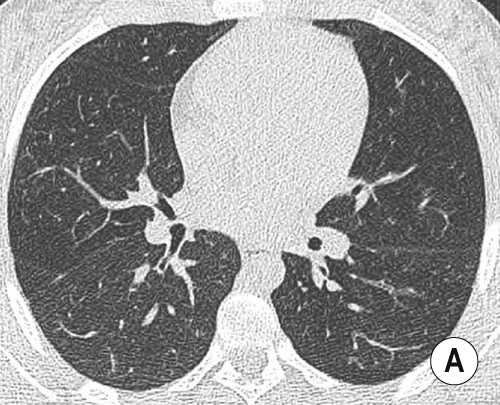
A non-specific feature representing a generalized increase in lung parenchymal opacification that does not obscure the pulmonary vessels ▸ it represents a combination of partial airspace filling, interstitial thickening and displacement of air from the lung
Causes: subacute hypersensitivity pneumonitis ▸ acute respiratory distress syndrome (ARDS) ▸ acute interstitial pneumonia (AIP) ▸ non-specific interstitial pneumonia (NSIP) ▸ diffuse pneumonias (particularly Pneumocystis jiroveci (P. carinii) pneumonia in AIDS patients)
Identification of dilated airways within areas of ground-glass opacification is usually an indication of fine fibrosis (and usually irreversible disease)
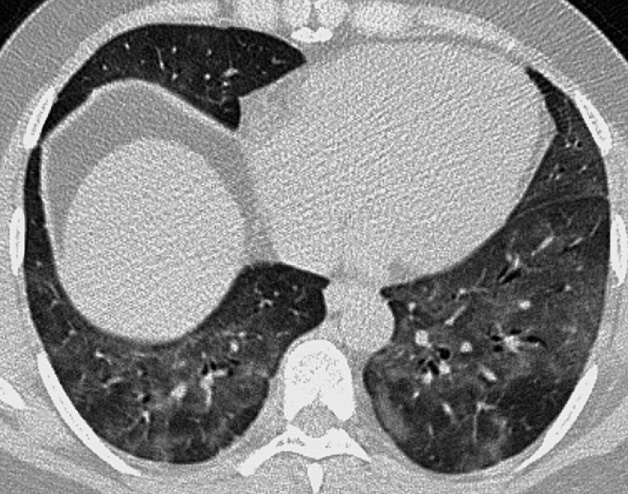
A non-specific sign representing regional lung parenchymal attenuation differences ▸ lung attenuation depends on the amount of blood, parenchymal tissue and air and is therefore a non-specific sign
This is the dominant abnormality in small airways disease, occlusive vascular disease and infiltrative lung disease
In small airways and occlusive vascular disease the ‘black’ lung demonstrating decreased attenuation is abnormal
In infiltrative lung disease the ‘grey’ lung demonstrating normal or increased attenuation is abnormal
Bronchial abnormalities and the presence of air trapping on expiratory CT are the most useful discriminatory features in identifying small airways disease as the cause of mosaic attenuation
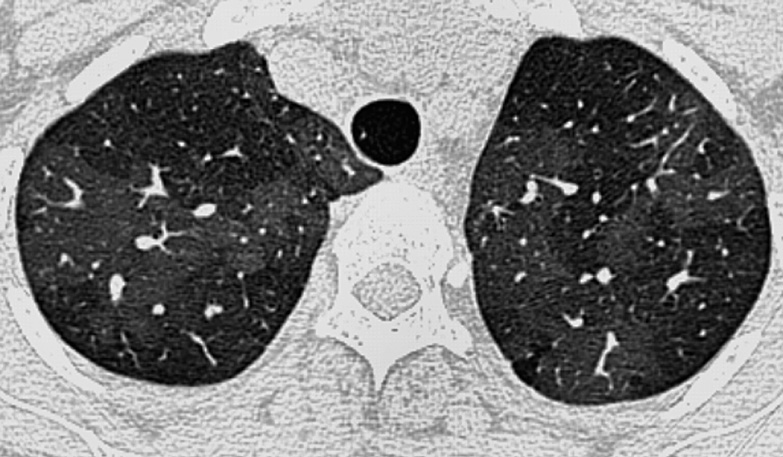
This is caused by thickened interlobular or intralobular septa or honeycomb (fibrotic) destruction ▸ it almost always represents significant interstitial lung disease (ILD)
Causes include infiltration by fibrosis (interstitial fibrosis), abnormal cells (lymphangitis carcinomatosa) or fluid (pulmonary oedema)
Smooth interlobular septal thickening: pulmonary oedema or alveolar proteinosis
Irregular interlobular septal thickening: lymphangitic spread of tumour or the nodular septal thickening seen in sarcoidosis
A fine reticular pattern (most commonly seen with idiopathic pulmonary fibrosis)
A coarse reticular pattern: this occurs with severe fibrosis and is characterized by interlacing irregular linear opacities ▸ an end-stage fibrotic (honeycomb) lung is characterized by cystic airspaces surrounded by irregular walls
Traction bronchiectasis/bronchiolectasis: extensive fibrosis can distort the lung morphology resulting in irregular segmental or subsegmental airway dilatation
Ground-glass opacification (if the septal thickening is very fine)
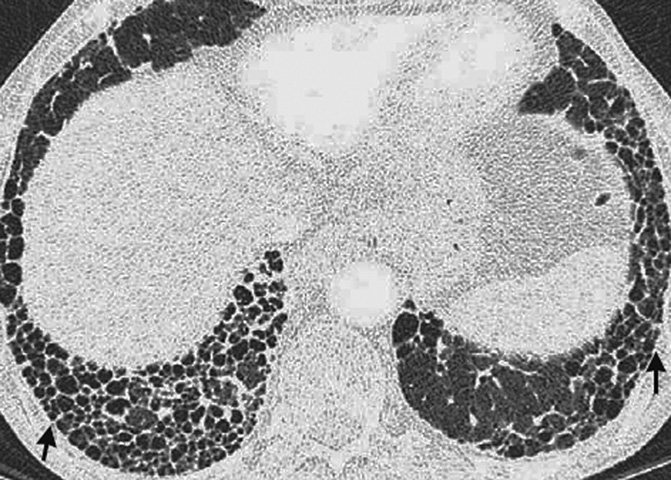
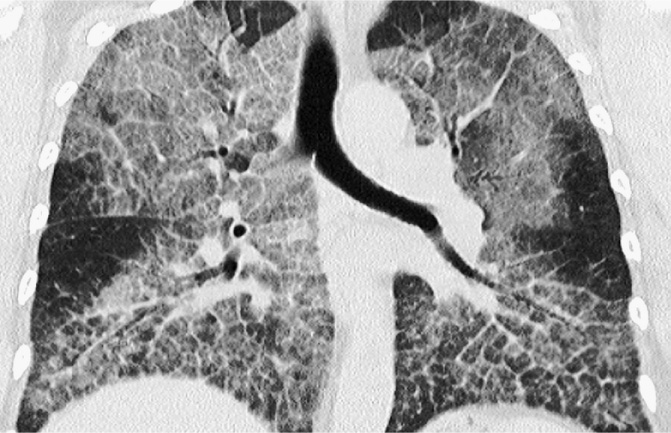
This is a feature of both interstitial and airspace disease
This is seen within the interlobular septa and the subpleural and peribronchovascular regions (especially those related to lymphatic vessels) ▸ nodules can be < 5 mm from the pleural surface
Causes: sarcoidosis ▸ lymphangitis carcinomatosa
These are related to endobronchial and small airway disease ▸ most peripheral nodules are > 5 mm from the pleural surface ▸ a ‘tree-in-bud’ appearance suggests endobronchial disease
Causes: subacute hypersensitivity pneumonitis ▸ respiratory bronchiolitis–interstitial lung disease (RB–ILD) ▸ diffuse panbroncholitis ▸ endobronchial spread of TB ▸ cryptogenic organizing pneumonia
The distribution is not related to the secondary pulmonary lobule and can involve the pleural surface
Causes: haematogenous spread of TB ▸ pulmonary metastases ▸ pneumoconiosis ▸ sarcoidosis (rare)
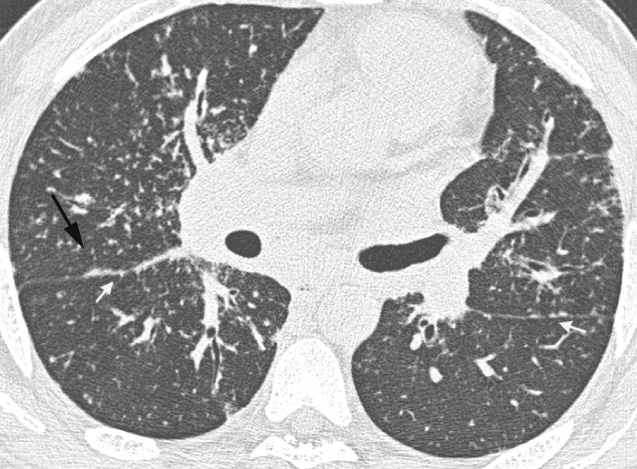
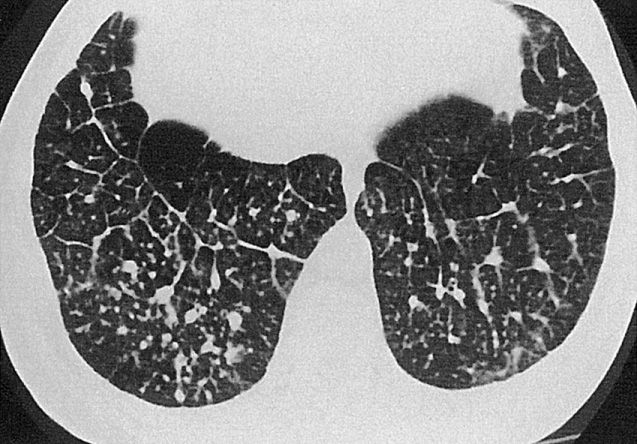
Progressive fibrosis and end-stage lung destruction of unknown cause
It is also known as cryptogenic fibrosing alveolitis (CFA) or usual interstitial pneumonia (UIP) ▸ UIP specifically refers to the histopathological pattern seen in patients with the clinical presentation of CFA or IPF
Cough ▸ dyspnoea ▸ weight loss ▸ clubbing ▸ it commonly affects patients who are 40–70 years old (M>F)
Bilateral asymmetric peripheral reticular opacities ▸ these are most profuse at the lung bases ▸ although there is associated volume loss, the lung volumes may be preserved or increased if there is coexisting emphysema
Ground-glass change is not predominant ▸ with disease progression the lung changes ‘creep’ around the lung periphery to involve the anterior aspects of the upper lobes (this is an important discriminator between UIP and other conditions with a similar clinical presentation) ▸ mediastinal adenopathy is frequently seen (up to 2 cm and unrelated to infection or malignancy) ▸ pleural effusions are uncommon ▸ pulmonary hypertension can be seen with severe disease
Early stage: ground-glass change
Late stage: a predominantly subpleural bibasal reticular pattern
End stage: areas of honeycomb destruction (end stage) with associated traction bronchiectasis
Other causes of a UIP-type histological pattern: chronic hypersensitivity pneumonitis ▸ asbestosis ▸ connective tissue disease ▸ rarely drugs
A confident HRCT diagnosis of UIP is difficult without honeycombing
Extent of fibrosis is predictive of survival and mortality
Varying degrees of interstitial inflammation and fibrosis without any specific features to allow a diagnosis of UIP or DIP to be made
As for UIP ▸ it commonly affects patients who are aged between 40 and 50 years (M = F)
A predominant pattern of ground-glass opacification (with a basal and subpleural distribution) ± associated airway distortion ▸ a reticular pattern is common ▸ there may be significant fibrosis (temporally uniform in comparison with UIP) but honeycombing is sparse ▸ abnormalities are usually peribronchovascular or peripheral, and occasionally spare the subpleural lung
NSIP may be distinguished from UIP by more prominent ground-glass attenuation, a finer reticular pattern and an absence of honeycombing
The heterogeneity of pathological processes encompassed by NSIP makes a confident CT diagnosis less likely than with UIP
NSIP has a better prognosis than UIP
A clinicopathological entity of an isolated organizing pneumonia seen in patients without an identifiable associated disease (e.g. infection, malignancy or connective tissue disease)
COP was previously known as bronchiolitis obliterans organizing pneumonia (BOOP)
A non-productive cough ▸ dyspnoea ▸ malaise ▸ weight loss ▸ it commonly affects patients during the 6 th decade (M = F)
Areas of patchy consolidation which is often subpleural and basal (with a propensity to progress and change location over time) ▸ there is lung volume preservation
Consolidation corresponding with areas of organizing pneumonia is commonly seen within the lower zones with either a subpleural or a peribronchial distribution (the peribronchial distribution is typically seen in patients with polymyositis or dermatomyositis) ▸ ground-glass opacification, subpleural linear opacities and a distinctive perilobular pattern is commonly seen ▸ the lung architecture is generally well preserved with cavitation rarely seen
‘Reverse halo’ sign: multifocal areas of ground-glass opacification with a surrounding rim of consolidation
There is usually a complete response to a long (2–3 months) course of high-dose steroids
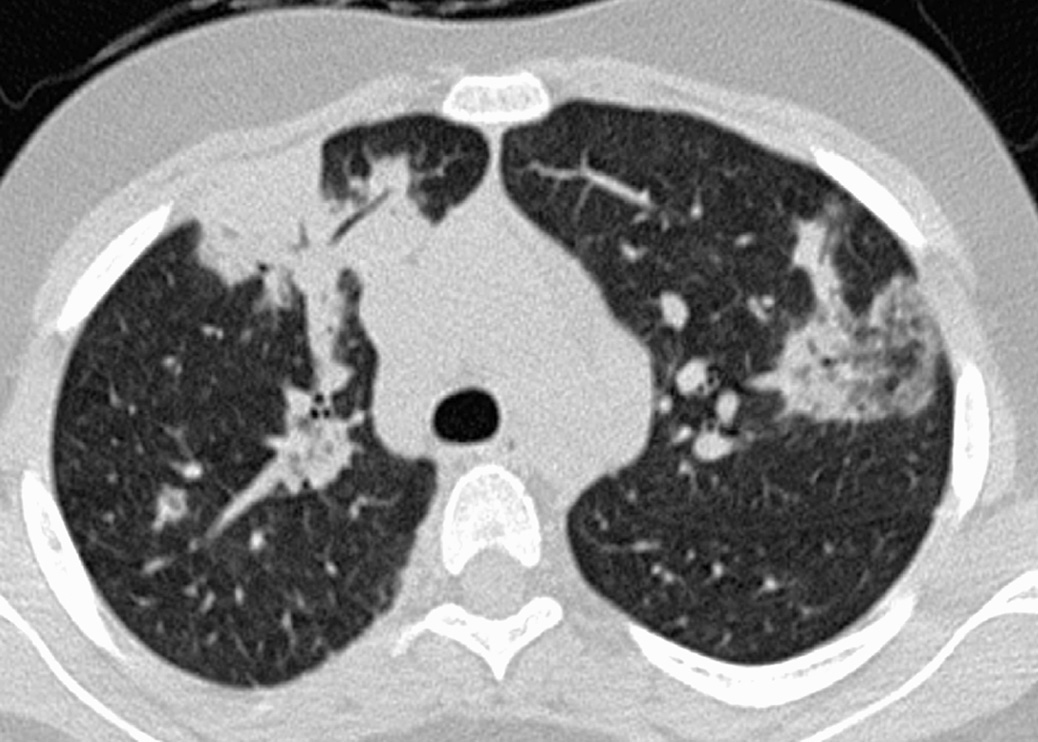
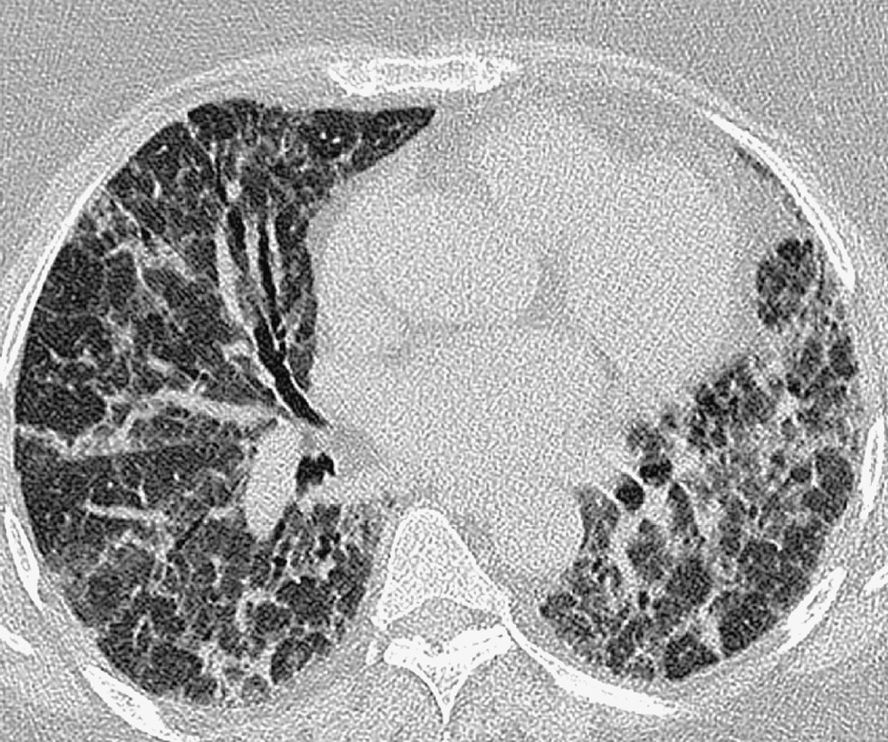
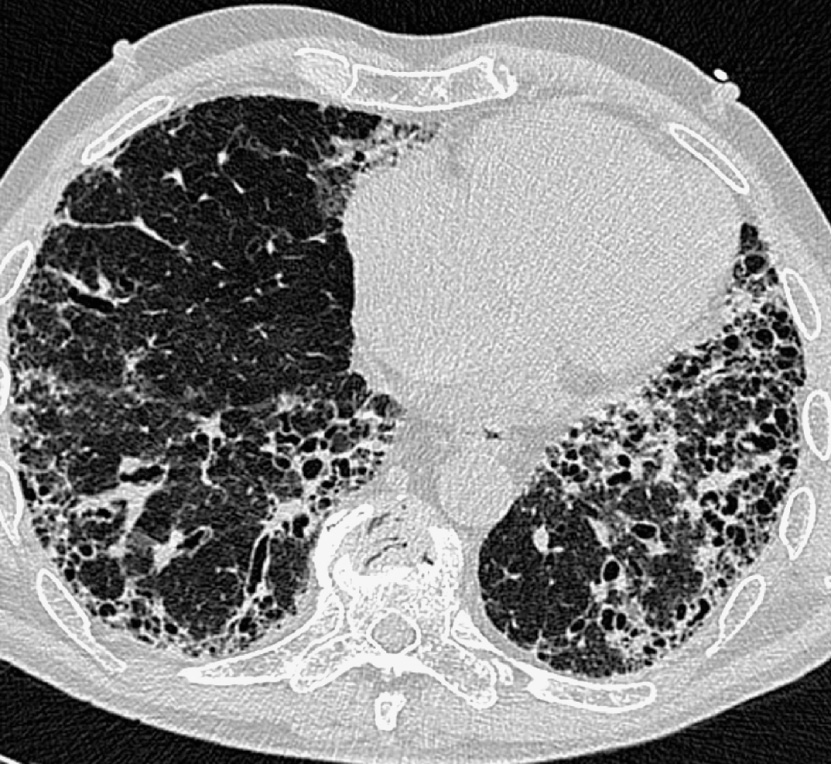
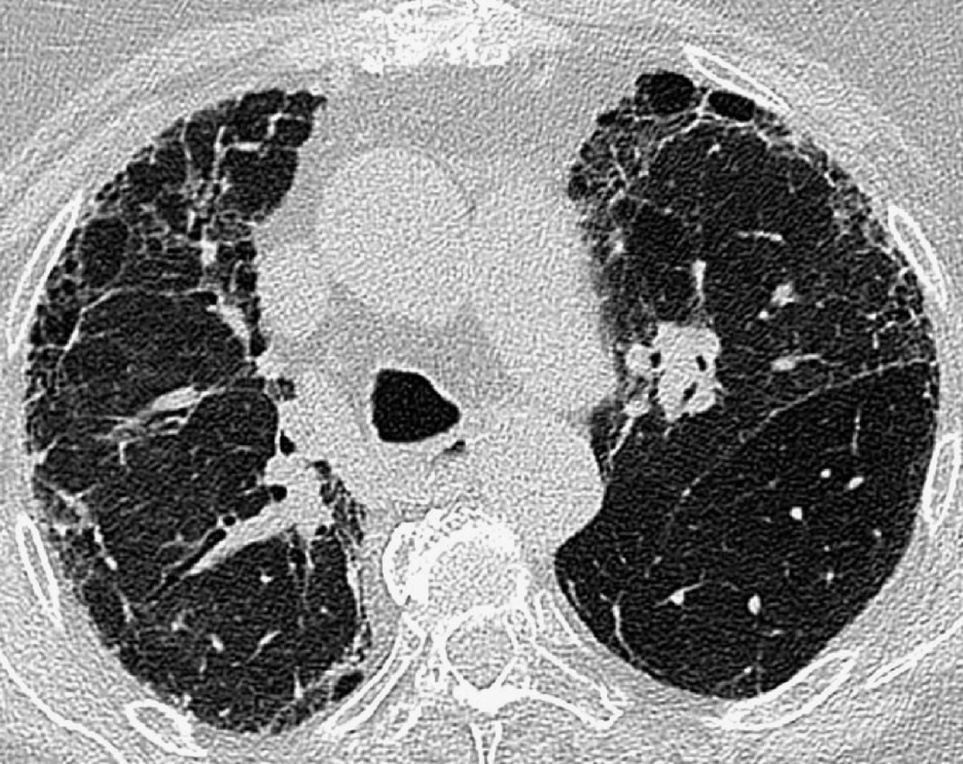
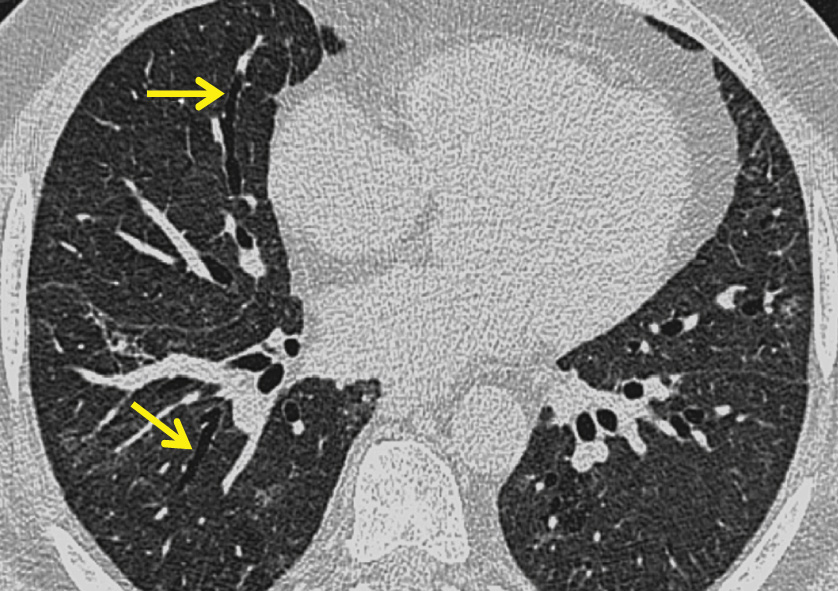
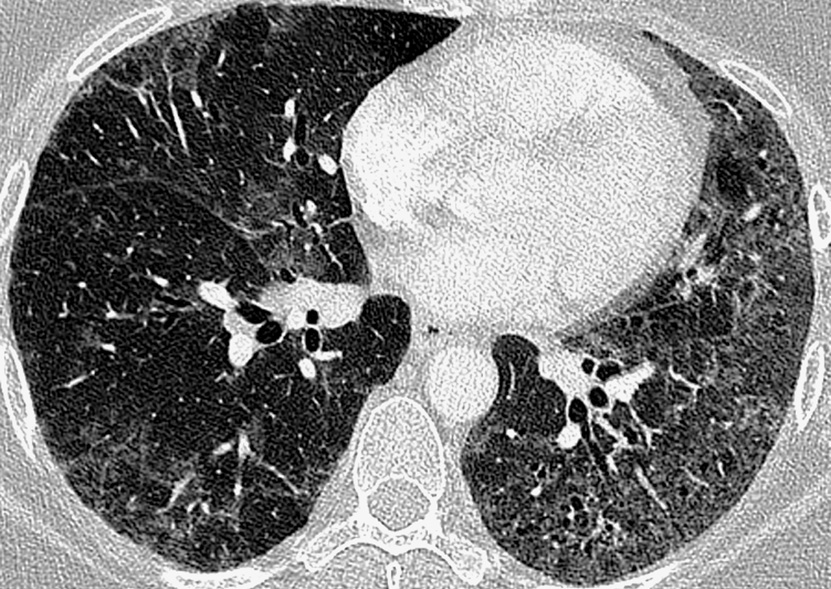
This is characterized by alveolar space filling with macrophages and a strong association with cigarette smoking
RB–ILD and DIP are part of the same disease spectrum, with DIP the more severe form
Insidious dyspnoea ▸ cough
This is relatively insensitive
RB–ILD: areas of patchy ground-glass opacification (due to macrophage accumulation within the alveolar spaces and ducts) ▸ poorly defined low attenuation centrilobular nodules ▸ upper lobe centrilobular emphysema and areas of air trapping (usually to a limited extent and reflecting the bronchiolitic element)
Thickening of the interlobular septa and features of interstitial fibrosis is unusual
DIP: ground-glass opacification is the dominant feature ▸ this typically affects the peripheral lower zones and may be patchy ▸ occasionally there are features of established fibrosis (which is usually to a limited extent)
It demonstrates a relatively stable clinical course
Smoking cessation is an important part of the management
Because of significant overlap, ‘smoking-related interstitial lung disease’ (SR-ILD) has been proposed to encompass DIP, RB-ILD, LCH and interstitial fibrosis
This is due to a widespread interstitial lymphoid lung infiltrate ▸ it resembles lymphoma but its clinical course is more akin to a chronic interstitial pneumonia
Progressive cough and dyspnoea (2F : 1M)
Nodules of varying sizes (which may be ill-defined) ▸ ground-glass opacification ▸ thickened bronchovascular bundles and interlobular septal thickening ▸ discrete thin-walled cysts lying deep within the lung parenchyma (measuring up to 3 cm)
Airspace disease, large nodules and pleural effusions are rare
Evolution to a frank lymphoproliferative disease is rare
It occurs in association with autoimmune diseases (e.g. Sjögren's syndrome), dysproteinaemias, autologous bone marrow transplantation, infection (viral, mycobacterial, HIV) and Castleman's disease
This can be regarded as an idiopathic form of adult respiratory distress syndrome (ARDS)
It consists of diffuse alveolar damage – there is an acute exudative phase with subsequent organizing and fibrotic phases
An acute onset with a similar presentation to ARDS (M = F)
Bilateral patchy airspace opacification
Ground-glass opacification and consolidation (all phases) ▸ bronchial dilatation and architectural distortion (fibrotic phase)
With resolution there is clearing of any ground-glass attenuation leaving residual fibrosis – fibrosis is more common than that seen in ARDS
It has a poor prognosis
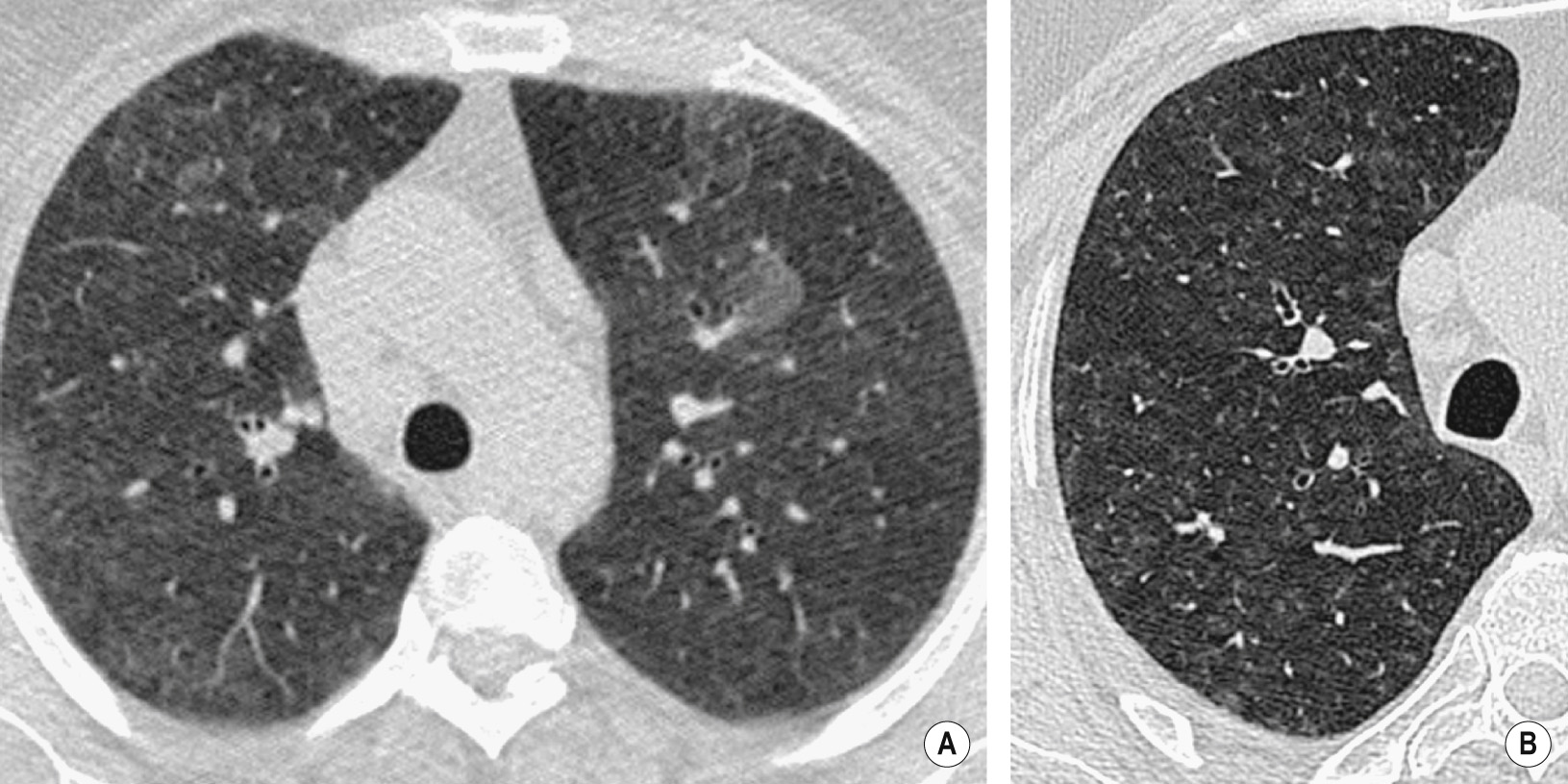
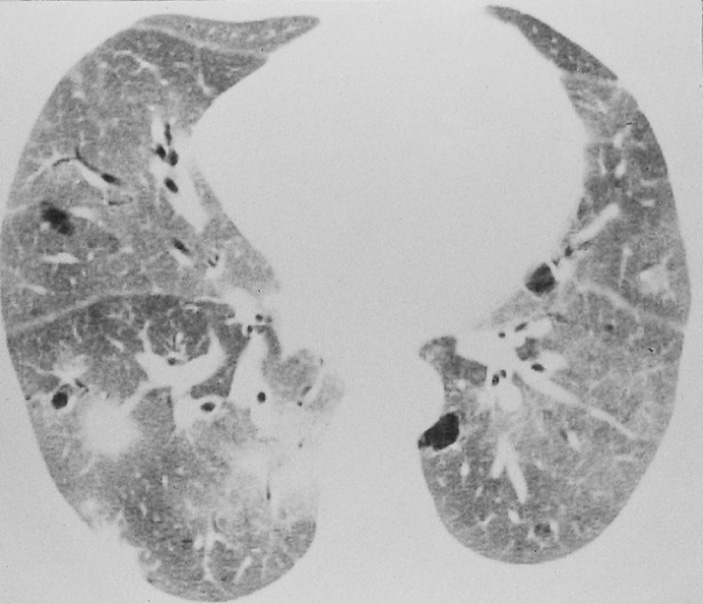
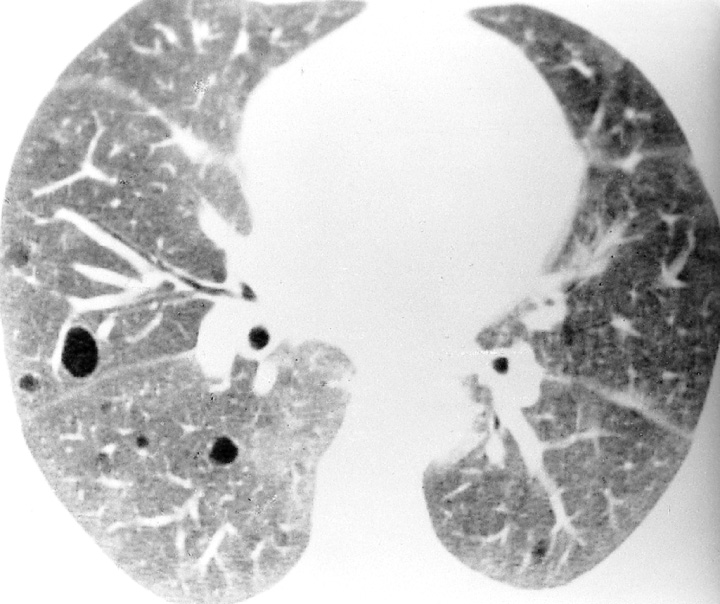
| Clinico–radiological–pathological criteria | Histological pattern | HRCT features * |
|---|---|---|
| Idiopathic pulmonary fibrosis | Usual interstitial pneumonia | Peripheral (subpleural) and basal reticular opacities ▸ honeycombing ▸ areas of ground-glass opacity (associated with traction bronchiectasis) |
| Non-specific interstitial pneumonia | Non-specific interstitial pneumonia | Areas of ground-glass opacity ± traction bronchiectasis ▸ minimal honeycombing |
| Cryptogenic organizing pneumonia | Organizing pneumonia | Peripheral or peribronchial consolidation ▸ areas of ground-glass opacity ▸ a perilobular pattern is increasingly recognized |
| Acute interstitial pneumonia | Diffuse alveolar damage | Consolidation (within the dependent lung) ▸ areas of ground-glass opacity ▸ traction bronchiectasis (organizing phase) |
| Respiratory bronchiolitis–interstitial lung (RB–ILD) | RB–ILD | Poorly defined centrilobular nodules ▸ areas of ground-glass opacity ▸ bronchial wall thickening ▸ limited emphysema |
| Desquamative interstitial pneumonia (DIP) | DIP | Areas of ground-glass opacity ▸ features of interstitial fibrosis |
| Lymphoid interstitial pneumonia (LIP) | LIP | Areas of ground-glass opacity ▸ poorly defined centrilobular nodules ▸ thickened interlobular septa ▸ thin-walled discrete cysts ▸ air trapping |
A multisystem non-caseating granulomatous disorder of unknown aetiology
The lungs, hilar and mediastinal nodes are the most commonly affected organ system
Other affected organs: skin > peripheral lymph nodes > eyes > spleen > CNS > parotid glands > bones
Fatigue ▸ malaise ▸ weight loss ▸ fever and night sweats ▸ dyspnoea ▸ erythema nodosum ▸ arthralgia ▸ 30% of patients are asymptomatic
Respiratory symptoms are most commonly seen in the black female population
Onset is usually during the 2 nd to 4 th decades (F>M)
Lung granulomas have a characteristic distribution along the lymphatics within the bronchovascular sheath, interlobular septa and subpleural regions
Lymph nodes appear lobulated with a well-demarcated outline (they can be massive) ▸ they can calcify in a characteristic ‘eggshell’ fashion ▸ airway or vascular compression is unusual
Garland's triad: bilateral symmetrical hilar and paratracheal lymphadenopathy
The lymphadenopathy can occasionally (1–5%) be asymmetrical or unilateral – marked asymmetry should bring the diagnosis into question ▸ unilateral paratracheal lymphadenopathy is usually right-sided (left-sided lymphadenopathy causes enlargement of the aortopulmonary window nodes)
40% of patients with nodal enlargement will develop parenchymal opacities within 1 year – of these ![]() ▸ will develop persistent fibrotic shadowing (± traction bronchiectasis)
▸ will develop persistent fibrotic shadowing (± traction bronchiectasis)
Nodal enlargement does not develop after parenchymal opacification
Become a Clinical Tree membership for Full access and enjoy Unlimited articles
If you are a member. Log in here